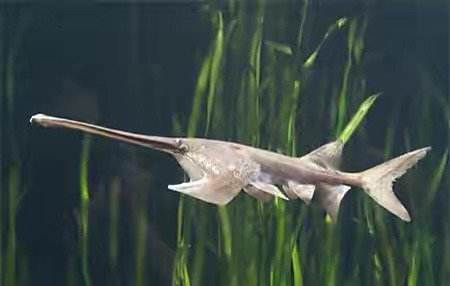The white sturgeon is one of the largest freshwater fish, named for its lighter color. It is also known as the harp fish, the swordfish, and the ancient name tuna. Like the Chinese sturgeon, it has existed for 150 million years and is one of the very few ancient fish that survived from the Cretaceous period of the Mesozoic Era.

Fish that are born in freshwater, migrate to the sea as young children, and then return to freshwater to spawn are called anadromous fish. The largest of these fish is the white sturgeon, which averages 2.3 meters long and weighs 65 to 130 kilograms. Sturgeons have diamond-shaped, enamel-like scales. Because the white sturgeon is very large, it can directly swallow many large freshwater fish. According to the records of Professor Bingzhi, a famous zoologist, several decades ago, someone caught a white sturgeon in Nanjing that was 7.5 meters long and weighed 908 kilograms. Sichuan fishermen also say that "a thousand pounds of Lazi (Chinese sturgeon) weighs ten thousand pounds of Xiang (white sturgeon)". Therefore, adult white sturgeons are almost invincible in the Yangtze River, at the top of the food chain, and are also known as the "King of Chinese Freshwater Fish".
The white sturgeon, a relic animal that survived the catastrophe, is extremely precious in scientific research, and the existing population is extremely small. For this reason, the "List of Key Protected Wildlife" issued twice by the Environmental Protection Committee of the State Council of China in 1983 and 1987 listed it as a Class I precious and rare animal under key protection. It belongs to China's national Class I protected wildlife. At that time, the scientific research department was working on artificial breeding research, but it was unable to carry out large-scale artificial breeding. It was strictly prohibited to catch and kill parent and young fish, and strongly advocated the return of young sturgeons to the river to protect and save this rare and endangered species.
In 2003, the white sturgeon that was mistakenly caught in Yibin was tall, up to 3 meters long and weighed 160 kilograms. So many years have passed, and the white sturgeon has never appeared in human vision again. Due to environmental changes, there are no natural conditions for the survival of the white sturgeon. This makes our understanding of it extremely limited, and we don’t even know much about its average lifespan, and can only roughly estimate it. Even some young researchers in the research team have never witnessed it in the wild.
Listed in the "Red List of Endangered Species of the World Conservation Union" (IUCN) 2009 ver 3.1-Critically Endangered (CR).
Listed in China's "National Key Protected Wildlife List" (February 5, 2021) Level 1.
On December 23, 2019, the Yangtze River white sturgeon (the genus white sturgeon contains only one species) was officially declared extinct.
On the evening of July 21, 2022, the International Union for Conservation of Nature and Natural Resources (IUCN) released an update report on the global species red list, announcing the extinction of the white sturgeon.
Protect wildlife and eliminate game.
Maintaining ecological balance is everyone's responsibility!